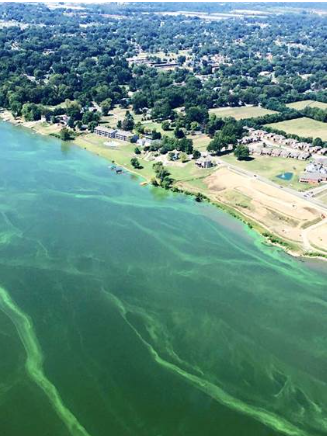September 23, 2015 – by the Kentucky Division of Water. Editor’s note: Valley Watch contacted Orsanco’s Environmental Specialist, Greg Youngstrom 9/23 to discuss the situation as it currently stands. We found that the farthest downriver the algae has bloomed is about thirty miles downriver from Louisville, approaching Leavenworth, IN. We will try to monitor the situation as and if it moves further downstream.
The Kentucky Division of Water (KDOW) and the Kentucky Department for Public Health (KDPH) are re-issuing a harmful algal bloom (HAB) recreational advisory for the Ohio River and tributaries, extending the advisory downstream from the West Virginia state line to the Cannelton Locks and Dam located at Cannelton, in Hancock County, Kentucky.
KDOW and Ohio River Valley Sanitation Commission (ORSANCO) personnel observed favorable water conditions for HAB development and made visual confirmation of HABs in the McAlpine pool at Louisville, Carrollton and Madison, Indiana. In addition, KDOW staff observed HABs in the Cannelton pool at West Point. Preliminary analysis indicates that microcystin toxins are occurring in these pools above advisory thresholds, which warrants the advisory to be extended downstream.
Water swallowed during recreational activities in this body of water may increase the risk of gastrointestinal symptoms such as stomach pain, nausea, vomiting and diarrhea. Skin, eye and throat irritation and/or breathing difficulties may also occur after contact.
On Aug. 31, KDOW received a report of an algal bloom on the Ohio River near Greenup. Subsequent sampling of the river indicated higher levels of microcystin toxins existed in some areas of the Ohio River from Ashland to the Meldahl Dam. KDOW issued a recreational advisory on Sept. 4 from the West Virginia line to Meldahl Dam. Since that time, conditions favorable for the development of HABs have persisted throughout the river basin, and additional HABs have formed further downstream.
On Sept. 11 the advisory was extended to the Markland Dam when data from the Markland pool indicated HABs were occurring throughout the pool. Observations of a significant bloom near Carrollton and Madison were made by ORSANCO staff on Sept. 16. On Sept. 17, KDOW staff observed blooms at Cox Park and Harrods Creek in Louisville and at Prospect. KDOW personnel also observed a significant bloom near West Point on Sept. 17. These observations and preliminary analysis indicate the need to extend the Ohio River and tributaries recreational advisory beyond the Markland Dam to the Cannelton Dam. This advisory includes the McAlpine pool which includes the area near Louisville. Samples have been collected and are being analyzed to confirm the presence of microcystin toxins.
This is a recreation advisory only.
There have been no detected microcystin toxins reported in the finished, treated water from public water systems which draw from the river. Precautions are being taken to monitor river water at public water supply intakes. The drinking water plants which draw from the river are optimizing their treatment to address the bacteria in the raw water, including using activated carbon and other treatment methods. KDOW will continue to sample and monitor the public water systems’ raw water and finished, treated water during the harmful algal bloom.
Harmful algal blooms arise when there are excess nutrients (phosphorus and nitrogen), sunny conditions, warm temperatures and low-flow or low-water conditions. KDOW anticipates that these conditions will persist in the Ohio River until flow in the river increases significantly and water temperatures decrease. At present, forecasts do not indicate significant changes in temperature and precipitation patterns over the next several weeks.
Blue-green algae occur naturally in the environment and are a vital part of the ecosystem. The more typical green algae, which do not produce toxins, come in many forms and may appear as underwater moss or stringy mats. Blue-green algae, on the other hand, appear as slicks of opaque, bright-green paint, but closer inspection often reveals the grainy, sawdust-like appearance of individual colonies or bacteria.
The color of the algae may also appear red or brown.
The following guidelines are recommended to avoid exposure to HABs:
- Individuals should avoid direct contact with affected water that has unusual color or where blue-green bacteria have been identified, including swimming, wading, paddling, diving and water skiing.
- People who are prone to respiratory allergies or asthma should avoid areas with HABs. Children may be particularly sensitive.
- If contact has been made with water containing blue-green algae, wash off with fresh water. In some cases, skin irritation will appear after prolonged exposure. If symptoms persist, consult your health care provider.
- If fishing in affected waters, fish fillets (not organs) may be consumed after the fillets have been rinsed in clean, non-lake water.
- Prevent pets and livestock from coming into contact with water where HAB is apparent. If you are concerned that you have symptoms that are a result of exposure to HABs please see your doctor and call your local health department.For additional information about this advisory, contact Andrea Keatley at the Kentucky Division of Water at (502) 564-3410 or Justin T. Carey, Division of Public Health Protection and Safety, Department for Public Health, at (502) 564-7398. http://water.ky.gov/waterquality/pages/HABS.aspx

